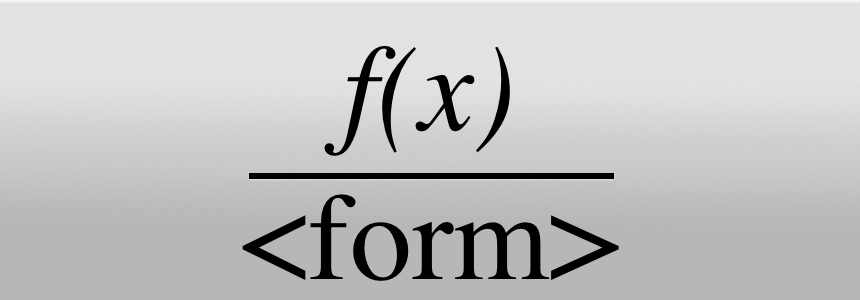

This is a theory that I have been studying for the past year and through observation believe that this can be applied to all situations that require a more efficient, functional solution. This paradigm has many names, but is best know as Occam’s Razor. His razor suggests that when resources are limited or when speed of function is essential, design / complexity trade-offs should be based on what does the least harm to the probability of success, however that is defined.
Form is Function
There is a school of thought that beauty in design results in good function, but I prefer to subscribe the fact that just concentration on the functionality will by its very nature, create its own aura of design. Sometimes, the focus on functional efficiency inspires a feeling that goes beyond aesthetics and ultimately give us the sense that its form is of a higher echelon.
Barrier To Entry
The brain is an amazing piece of kit. One of its most amazing functions is its ability to optimise when processing data. Each brain has been trained over many years (or maybe it inherently has the ability) to simplify individual objects into groups. Instead of seeing each individual blade of grass, the mind sees a field. Millions of pieces of data grouped into one object because it knows, to comprehend millions of pieces of grass would take and enormous amount of effect. Effect that could be focused elsewhere. So it generalises to make life easier. This sort of information overload can happen in design as well; Too much will distract from your likely objective.
Remember that 7 Second Rule? If your web app or website has 7 seconds to impress then wouldn’t you prefer showing off your functional muscles? How useful your app is? and not long it takes to load the really cool (bandwidth crunching) design? Remember how it easy it is to make your mind up about someone when you them for the first time. Same rules apply.
Just Do It!
What are yoru objectives and goals? Hopefully, when developing a web app or website, to make your (or your users) life easier! And let’s remember, this ‘thing’ we call the Internet is broken. So don’t break any further with dodgy CSS and bloated javascript. Functional Turn Around is the most impressive aspect for me these days. Spend time developing how the app works, refine it, refine it again, then again. Then when it works, design around the edges.
If you like latin phrase then try this one:
“entia non sunt multiplicanda praeter necessitatem“, or “entities should not be multiplied beyond necessity”
or just remember, K.I.S.S – Keep it Simple, Stupid!
As Einstein put it:
“Everything should be made as simple as possible, but not simpler.”
Einstein is sometimes quoted wrongly with the above, as some people have interrupted it as “keep thing as simple as possible” or what some people call Occam’s Razor. But I disagree. When he says about “but not simpler”, he was actually referring to the Golden Mean.
As Aristotle said about the Spartan way of life; How they trained Men, not women and how they trained for War but not for peace. Aristotle knew that this is not a good way to live. If there were no enemies to fight, what would happen? Such disharmony creates greater difficulties in the future.
What does this mean in design and development?
Ancient Greek structural design is based on symmetry and proportion. Modern research also suggests that people whose facial features are symmetric and proportioned according the golden ratio are looked upon as more attractive than those whose faces are not.
The Golden Number
The Golden Number has been much publicised in the fantastic book, “The Da Vinci Code”. Phi, (1.61803… etc) appears throughout life and the universe. A few believe that Phi is the most efficient outcome, the result of natural forces. Others believe it is a universal constant of design, and the signature of God’s handwork.
Phi is used in Art; masterpieces such as Leonardo Da Vinci’s “The Last Supper”, The Parthenon, the famous Greek temple built for the goddess Athena, Biology; proportions of the human body and faces and Mathematics; Phi is found within Geometry.
What does this mean in life?
There is a word that is used constantly now days which (apparently) if we can achieve, we will live a happier, longer, more fulfilling life; Balance. Balance is the middle of the average or the Golden Mean. A healthy balanced diet, a balanced working life, being within the average weight for your height. Pleasure / Pain? Obtaining the Golden Mean allows us to enjoy all life’s pleasures without becoming to obsessed with, for example, Chocolate or Rabbit food. Enjoy both!
Summary
Life is a balance and if we stay within the realms of this, we will enjoy the most of what the experience of living can bring us. Look towards the Golden Mean (and its applied use) for inspiration when developing an “experience”, be it life, a piece of work or design, or a movie. Explore all the different shades but obtaining the “Mean” provide us / the viewer / the user with the balance that we / they require.
As a side note, when dealing with functional outcomes, we should look at Occum’s razor. Which being us back to another quote:
“When you have two competing theories which make exactly the same predictions, the one that is simpler is the better.”
More information about Occum’s Razor.
This week, I’ve heard some noise about the ‘misconception’ that WYSIWYG builders can make websites faster than traditional methods; coding from scratch. There’s an argument that coding a site from scratch is more efficient and, ultimately, faster…
I, on the other hand, have the complete opposite view; It’s a misconception that coding from scratch can build you a site faster.
What people always forget is that we almost never create a site inside a bubble. Most sites are created for a function rather than art; to be purposeful rather than just ‘be’.
A purposeful website would be a site created for clients to use professionally or for a group to raise awareness of there topic, charity or product. With this in mind, there will always be outside influences that affect the building of a website; change of design and layout, 11th hour functionality additions and generally a world of constant change in our clients needs.
Coming from a web agency that built websites and systems for clients, we felt strongly that there is a better way to build the solutions we were employed to create. 90% of the work we were doing was repetitive; PSD slicing, CSS perfection, cross browser compatibility issues, adding forms and hooking them up to databases, putting Google Maps in via Javascript and coding in the marker locations, etc. We wanted build a platform that meant we could to build once, so that we could deploy many. That way, we could become more efficient and start to put our time into the parts of a project that really added value to our customers. And add value to ourselves, as designers / programmers.
My point is that when it comes to building websites, is not just about being able to write code fast! There are parts of the project that are never factored in when speed is considered. You need to look at the project as a whole and then weigh up if coding is faster…
From Design, to Code to Content to ongoing Maintenance.
“So…”, I hear you ask, “why didn’t you use a WYSIWYG editor when you were building sites for clients?”
This one is simple to answer and I’m sure resonates with every web designer out there…
Quality
The stigma of WYSIWYG editors is that they produce really bad code, which, in turn, would have cost us more time (than programming from scratch) to sort out the mess to get something half decent.
We looked at the many Page Builders that are currently out on the market and were shocked at the sub-standard quality results that most produce. On all levels; design, code, management and flexibility. Most are leaky and lacking. They don’t allow you to import your own custom designs have restricted layouts and do not even have the basic functionality to create even some of the simplest websites, i.e. creating custom forms and using data in meaningful ways. We simply couldn’t use them because we there was no way to obtain the quality our clients have come expect.
We wanted more for BaseKit; we wanted more efficiency but not at the expense of quality. This is our core aim for the team at BaseKit; We want to our enable our users to create websites that are professional, dynamic and produce compliant quality code.
We understand more than anyone that pumping out crap doesn’t help anyone!
The team are spending time perfecting the quality of BaseKit websites; we are cutting down the code up that is output, minifying our site size down and are aiming to get even the most complex BaseKit sites easily though W3C strict mode. It’s going to be bloody hard to create a coding horror with BaseKit once we’ve finished!
In Conclusion, I believe that WYSIWYG editors allow you to build websites faster than coding, BUT all the ones I’ve seen have massive quality issues that make the creating process anti-efficient. Coding in scratch therefore is perceived is faster but most forget about the other aspects of creating a site (basically, the client’s changing ‘needs’). BaseKit is a perfect platform to help us with visual perfection, reduce repetition and tackle change in scope.
WYSIWYG will ALWAYS be faster way to create websites when quality results are produced. A concept that is core to the BaseKit platform.

We've had people screaming out for a BaseKit blog feature for years but there was a strong decision made to not release the blog feature for the V6 (our previous editor). The product team here are always concerned about releasing the best possible product. We released that for blog to work effectively, we needed to have a data driven engine... classic CMS.
Our V6 editor fundamentality was built with design in mind; you could drop widgets anywhere on the page. The problem with a design-centric methodology was that it makes it very hard to define what a piece of content is; where is user's logo on the page if they can drop it anywhere. Semantics was an after thought with V6.
When we started building our V7 editor, we had this in mind. We built the framework from the ground up with semantics and data in mind. Profile data is centralised so data such as a companies logo or address can be changed in one place and updated across the whole site.
We wanted to wait for this data-centric framework to solidify before we moved forward to super data-centric features such as Blog, Ecommerce and Menu.
I've been using this in depth for months and i'm extraordinarily excited about this feature. It's important to me (and us at BaseKit) that we give you, the blogger, a simple content editing experience so you can build awesome blogs. And there is more to come too!
So here it is! Four years in the making! I hope you enjoy it as much as we have!